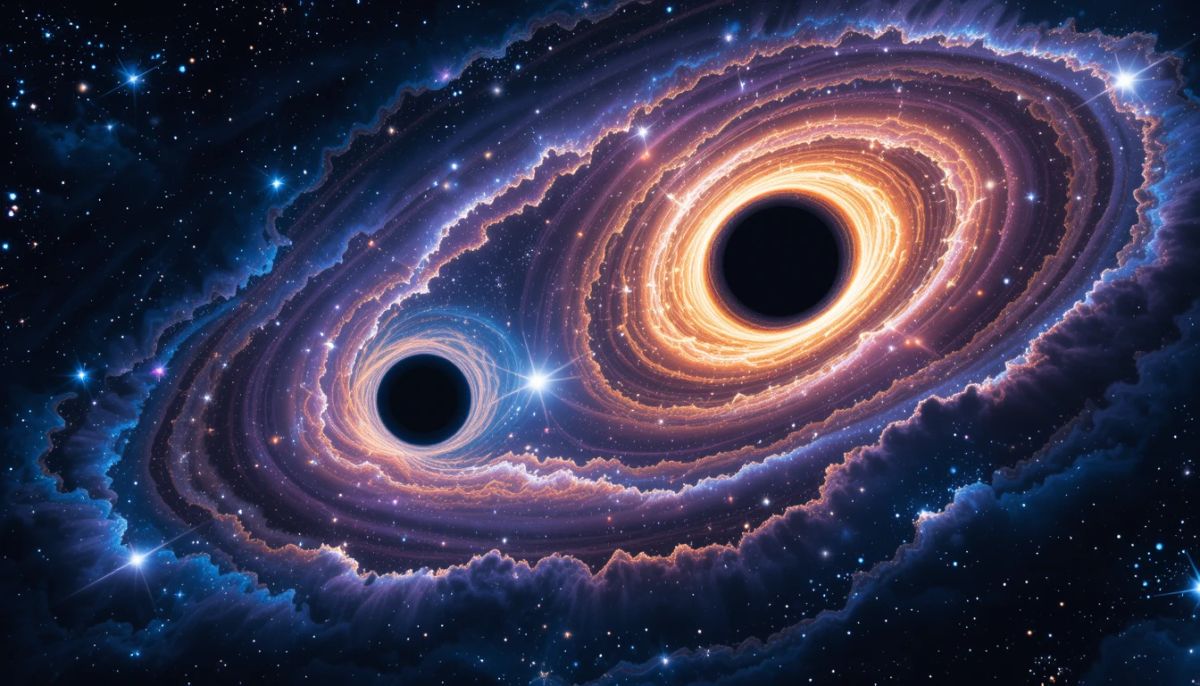Researchers have made a remarkable discovery in the field of astrophysics: a dual active black hole system within a disk galaxy. What sets this finding apart is the substantial mass difference between the two black holes, presenting a mass ratio of approximately 7:1. The discovery, based on detailed galactic kinematics and emission-line data, sheds light on the effects of galactic mergers, black hole evolution, and galactic outflows.
Unveiling the System
The investigation focused on a galaxy known as SDSS J1445+4926, an edge-on disk galaxy from the MaNGA Survey. The galaxy displayed a notable biconical gas outflow and abnormal gas kinematics situated around 1 kiloparsec (kpc) from its photometric center. Researchers identified two black holes:
- Primary Black Hole: Approximately 9.4×10^6 M⊙, located at the galactic center, associated with galactic-scale outflows.
- Secondary Black Hole: Roughly 1.3×10^6 M⊙, off-centered by 0.94 kpc, producing distinct emission-line spectra, including broad and narrow Hα components.
Formation and Evolution
This unique system likely formed through a minor merger between galaxies with disproportionate stellar masses. While previous studies primarily focused on major mergers with nearly equal galaxy masses, this discovery provides critical insights into the dynamics of smaller galactic collisions.
Simulations predict that:
- Ram pressure stripping and tidal forces during merger events limit gas accretion onto the less massive black hole.
- Minor mergers are expected to produce fewer simultaneous active black hole systems.
Observational Evidence
Researchers used integral field spectroscopy (IFS) and multi-wavelength imaging techniques to gather the following evidence:
- Velocity Field Analysis: Gas near the secondary black hole exhibited redshifted velocities between 300 to 400 km/s, distinct from the central gas kinematics.
- Emission Line Diagnostics: The secondary black hole generated a Seyfert-like narrow-line region (NLR) and broad Hα emissions with a dispersion of 700–850 km/s.
- BPT Diagrams: These diagnostic plots confirmed the presence of active galactic nucleus (AGN) emissions at both black hole sites.
Implications for Galactic Evolution
This discovery highlights the role of minor mergers in black hole and galaxy evolution. Key implications include:
- Understanding Black Hole Growth: Evidence from this system supports theories that black hole growth can persist even during minor mergers.
- AGN Contributions to Galactic Winds: Outflows driven by dual black holes may play a significant role in regulating star formation and shaping galactic structures.
- Future Gravitational Wave Detection: Such systems could be potential progenitors for detectable gravitational wave events.
Challenges and Future Directions
Several questions remain:
- Complex Kinematics: Researchers are exploring whether the gas motions could also be explained by jets or inflows instead of a second black hole.
- Dust Extinction Effects: Further studies are needed to assess the impact of dust attenuation on emission-line visibility.
Upcoming high-resolution multi-band observations are essential to confirm these findings and further investigate the interactions between the black holes and their host galaxy.
Conclusion
The discovery of a dual black hole system with a 7:1 mass ratio offers unprecedented insights into galactic dynamics and black hole co-evolution. As researchers continue to unlock the mysteries of such systems, the findings promise to reshape our understanding of galactic formation and evolution in the cosmos.
FAQs:
What makes this discovery unique?
The substantial mass ratio (7:1) between the two black holes in a disk galaxy sets it apart from previous studies focused on equal-mass systems.
How was the discovery made?
Through the MaNGA survey, detailed velocity field analysis, and emission-line diagnostics using integral field spectroscopy.
What are the implications for black hole research?
It expands understanding of minor galactic mergers, AGN-driven outflows, and black hole evolution.
